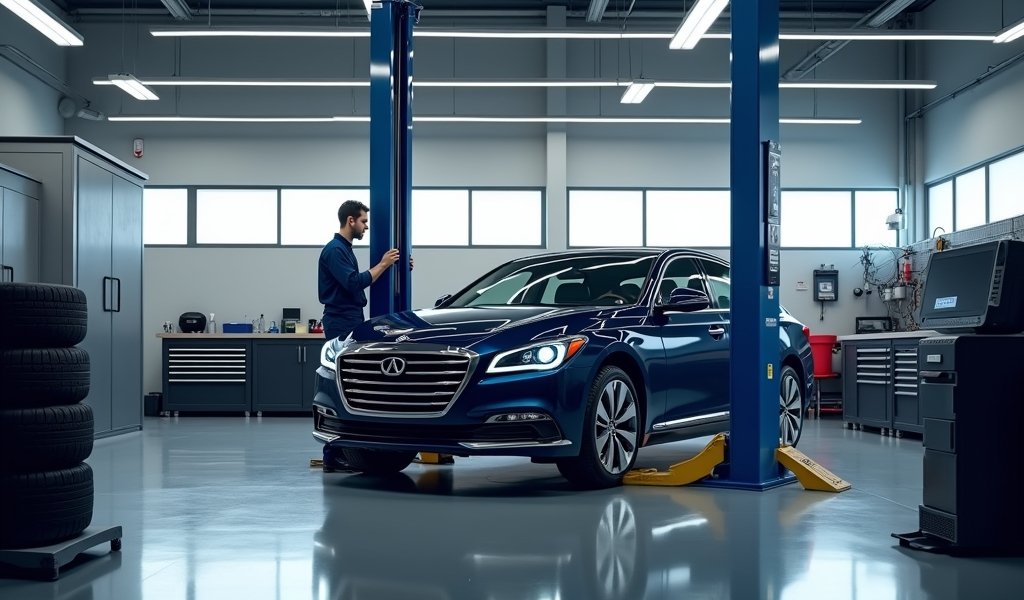Overview
This article outlines seven essential car maintenance practices that extend vehicle lifespan: regular oil changes, proper tire care, fluid checks, filter replacements, battery maintenance, brake system upkeep, and following manufacturer-scheduled services. Written by a London mechanic, it emphasizes how consistent preventive maintenance saves money, improves performance, and enhances safety compared to only addressing problems after they occur.
Table of Contents
- Introduction to Car Maintenance
- 1. Regular Oil Changes: The Lifeblood of Your Engine
- 2. Tire Maintenance: The Foundation of Safe Driving
- 3. Regular Fluid Checks: Keeping Your Car’s Systems Hydrated
- 4. Filter Replacements: Let Your Car Breathe Easy
- 5. Battery Care: Powering Your Journey
- 6. Brake System Maintenance: Safety First
- 7. Following Scheduled Services: Your Car’s Health Plan
- Conclusion
- Frequently Asked Questions
Introduction to Car Maintenance
When it comes to best car maintenance practices, I’ve seen it all in my years under the hood. I’m Adam Mechanic, and since founding my shop in London in 2021, I’ve noticed a pattern: vehicles that receive consistent care simply last longer. It’s not rocket science, but it is automotive science.
Your car is probably one of your most significant investments, second only to your home. Yet many drivers overlook simple maintenance tasks that could add years to their vehicle’s life. In my workshop, I regularly see premature wear and costly repairs that could have been prevented with basic upkeep.
The good news? You don’t need to be a mechanic to implement effective routine vehicle maintenance. This guide will walk you through seven proven maintenance practices that can dramatically extend your car’s lifespan, improve performance, and ultimately save you money. These aren’t just theoretical tips—they’re the same recommendations I give to my clients every day.
Let’s dive into these practical maintenance strategies that will keep your vehicle running smoothly for years to come, regardless of make or model.
1. Regular Oil Changes: The Lifeblood of Your Engine
If your engine is the heart of your vehicle, then oil is undoubtedly its lifeblood. In my garage, the most common cause of premature engine failure I encounter is inadequate oil changes. Engine oil does far more than just lubricate—it cools engine components, prevents corrosion, and carries away harmful particles.
How often should you change your oil? While older guidelines suggested every 3,000 miles, modern vehicles and synthetic oils have changed the game. For most newer cars, every 7,500 to 10,000 miles is sufficient, but always defer to your owner’s manual. If you regularly drive in severe conditions (extreme temperatures, frequent short trips, towing heavy loads), you’ll need more frequent changes.
Here’s what happens when oil change intervals are neglected:
- Oil breaks down and becomes sludge-like
- Engine parts experience increased friction and wear
- Heat dissipation becomes less efficient
- Contaminants accumulate and damage sensitive components
During an oil change, don’t just swap the oil—replace the oil filter too. This small part captures contaminants that could otherwise circulate through your engine. According to research from Edmunds, regular oil changes can extend engine life by tens of thousands of miles.
Remember, checking your oil level monthly between changes is equally important. Low oil levels can lead to catastrophic engine damage in a matter of minutes—I’ve seen perfectly good engines destroyed simply because they ran dry.
2. Tire Maintenance: The Foundation of Safe Driving

Your tires are the only part of your vehicle that actually touches the road, making them critical for safety, performance, and efficiency. After checking thousands of vehicles in my London shop, I’ve found that tire maintenance is often overlooked until something goes wrong.
Proper tire pressure is the simplest yet most effective maintenance task. Underinflated tires wear faster, reduce fuel economy, and compromise handling. Overinflated tires provide a harsher ride and wear unevenly. I recommend checking tire pressure at least monthly and before long trips. The correct pressure isn’t what’s printed on the tire itself—it’s what’s listed on the placard inside your driver’s door jamb or in your owner’s manual.
Tire rotation is equally essential. Front and rear tires wear differently due to weight distribution, steering, and drive configuration. By rotating tires every 5,000-7,000 miles, you’ll ensure even wear and maximize their lifespan. The typical rotation pattern depends on your vehicle’s drive type:
- Front-wheel drive: Front tires move to the rear, rear tires move to the opposite side at the front
- Rear-wheel drive: Rear tires move to the front, front tires move to the opposite side at the rear
- All-wheel drive: Cross-rotation pattern is often best (consult your manual)
Don’t forget to check tread depth regularly. The legal minimum in most places is 1.6mm, but for optimal safety, especially in wet conditions, I advise replacing tires when tread reaches 3mm. The penny test works in a pinch—insert a penny with Lincoln’s head upside down into your tread groove. If you can see the top of Lincoln’s head, it’s time for new tires.
Alignment and balancing are the unsung heroes of tire maintenance. If your steering wheel vibrates or your vehicle pulls to one side, you likely need balancing or alignment service. These issues not only affect comfort but dramatically accelerate tire wear and reduce fuel economy.
3. Regular Fluid Checks: Keeping Your Car’s Systems Hydrated
Your vehicle relies on several crucial fluids beyond just oil, and neglecting any of them can lead to expensive repairs. In my diagnostics experience, fluid-related issues account for approximately 30% of the preventable breakdowns I see.
Transmission fluid is particularly vital. Unlike engine oil, transmission fluid doesn’t burn off, but it does deteriorate and collect debris over time. Many modern transmissions claim to have “lifetime” fluid, but I’ve seen enough failed transmissions to strongly recommend changes every 60,000-100,000 miles. The color tells you a lot—healthy transmission fluid is pinkish-red and clear. If it’s brown, dark, or smells burnt, it’s time for a change.
Coolant (or antifreeze) prevents your engine from both freezing and overheating while also preventing corrosion in your cooling system. Most newer vehicles use long-life coolant that should be replaced every 5 years or 100,000 miles. However, I always recommend checking coolant levels and condition during seasonal changes. Never open a radiator cap when the engine is hot—the pressurized system can cause severe burns.
Other essential fluids to monitor include:
- Brake fluid: Should be checked and replaced every 2-3 years regardless of mileage
- Power steering fluid: Check monthly for leaks and proper levels
- Windshield washer fluid: Simple but critical for visibility during inclement weather
Creating a simple car service checklist for fluid checks can help you stay on top of these maintenance items. I recommend a monthly walk-around your vehicle to check for any leaks on your driveway or parking spot, as these are often the first sign of fluid problems.
4. Filter Replacements: Let Your Car Breathe Easy
Filters are the unsung heroes of vehicle maintenance. Just as we need clean air and water, your car relies on clean fluids and air to function properly. Throughout my career, I’ve seen countless performance issues solved with simple filter replacements.
The air filter prevents dust, debris, and contaminants from entering your engine. A clogged air filter restricts airflow, reducing engine performance and fuel economy. Most manufacturers recommend replacing it every 15,000-30,000 miles, but if you drive in dusty conditions, you’ll need more frequent replacements. It’s a simple visual check—hold it up to a light source, and if light doesn’t pass through easily, it’s time for a new one.
The cabin air filter is often forgotten but directly impacts your comfort and health. This filter cleans the air coming through your HVAC system, removing allergens, pollutants, and odors. If you notice reduced airflow from your vents or persistent odors, your cabin filter is likely overdue for replacement. For most vehicles, replacing it annually or every 15,000 miles keeps the air inside your car fresh.
Fuel filters trap contaminants that could otherwise damage your fuel injectors and engine. While some newer vehicles have lifetime fuel filters integrated into the fuel pump assembly, many still require periodic replacement. A clogged fuel filter causes hesitation, reduced power, and potential stalling. Replace according to your manufacturer’s schedule, typically every 30,000-60,000 miles.
The oil filter should be replaced with every oil change. This filter removes particles from your engine oil that could otherwise cause premature wear. Skimping on filter quality is false economy—I always recommend using OEM or high-quality aftermarket filters rather than budget options.
According to the U.S. Department of Energy, a clean air filter can improve acceleration time by up to 11% and replacing a severely clogged air filter can improve fuel economy by up to 10% in older vehicles.
5. Battery Care: Powering Your Journey

The battery is the electrical heart of your vehicle, and even the most meticulously maintained engine won’t start without a healthy one. In my London workshop, battery failures spike dramatically during winter months, but proper maintenance can prevent most of these issues.
Modern vehicles have increasingly complex electrical systems that place greater demands on batteries. The average battery lifespan is 3-5 years, but this varies based on climate, driving habits, and vehicle requirements. Extreme temperatures—both hot and cold—accelerate battery degradation. If you regularly take short trips, your battery may not fully recharge, further shortening its life.
Visual inspection can reveal early warning signs. Look for:
- Corrosion on terminals (appears as white, blue, or greenish powder)
- Bulging or cracking of the battery case
- Low fluid level in non-sealed batteries
- Loose battery connections
Cleaning battery terminals with a mixture of baking soda and water (after disconnecting) prevents corrosion-related starting issues. Ensure connections are tight but not overtightened. For vehicles driven infrequently, a battery tender or maintainer can prevent discharge during storage.
Most auto parts stores offer free battery testing. I recommend having your battery tested annually after it reaches three years of age. This simple test can predict failure before you’re stranded. If your battery is showing signs of weakness, replace it proactively rather than waiting for failure—especially before extreme weather seasons.
For those with the DIY spirit, learning how to safely jump-start a vehicle is essential knowledge. Keep quality jumper cables in your vehicle, and familiarize yourself with the proper procedure to avoid dangerous situations or electrical system damage.
6. Brake System Maintenance: Safety First
Your brake system isn’t just about stopping—it’s about controlling your vehicle in all situations. As a mechanic specializing in safety systems, I can’t overstate the importance of regular brake maintenance. This system literally stands between you and potential accidents.
Brake pads wear with use and require periodic replacement. Most modern vehicles have wear indicators that produce a squealing sound when pads need replacement. However, don’t wait for the noise—visual inspection during tire rotations is the best practice. As a general guideline, brake pads typically last 30,000-70,000 miles depending on driving habits and conditions.
Brake rotors (discs) should be inspected alongside the pads. Rotors can develop grooves, cracks, or become warped from heat. While resurfacing (turning) rotors was once common practice, the cost difference between resurfacing and replacement has narrowed, and many modern rotors are too thin to safely resurface.
Brake fluid absorbs moisture over time, lowering its boiling point and potentially causing brake fade during heavy use. This hygroscopic property means brake fluid should be replaced every 2-3 years regardless of mileage. You can check fluid condition with test strips, but the color offers clues too—fresh fluid is clear or slightly amber, while darkened fluid indicates contamination.
Other brake components requiring attention include:
- Brake calipers: Can seize if not maintained, causing uneven braking
- Brake hoses: Should be inspected for cracks or bulges
- Parking brake: Needs periodic adjustment to maintain effectiveness
Warning signs that shouldn’t be ignored include grinding noises, pulling to one side when braking, a soft or spongy pedal, vibration during braking, or increased stopping distance. These symptoms indicate potentially serious issues requiring immediate attention.
Through my years of experience, I’ve found that implementing comprehensive car maintenance tips that include regular brake inspection can prevent costly repairs and, more importantly, ensure your safety on the road.
7. Following Scheduled Services: Your Car’s Health Plan
Your vehicle’s manufacturer has invested millions in research to determine optimal maintenance intervals. The scheduled maintenance plan in your owner’s manual isn’t a suggestion—it’s a carefully calculated prescription for maximum vehicle longevity. In my professional experience, vehicles that follow these schedules consistently outlast those that don’t by 30-50% in terms of usable lifespan.
Major service intervals typically occur at 30,000, 60,000, and 90,000 miles. These milestones often include more comprehensive inspections and replacements than regular maintenance. Components like timing belts, water pumps, and spark plugs are typically addressed during these services. Postponing these critical services often leads to compound problems—a delayed timing belt replacement, for instance, can result in catastrophic engine damage if it fails.
Modern vehicles include sophisticated onboard diagnostics that monitor numerous systems. When your vehicle displays a check engine light or maintenance reminder, it’s communicating a specific need. Ignoring these warnings is like ignoring chest pain—the underlying issue rarely resolves itself and often worsens.
Keeping detailed maintenance records serves multiple purposes. First, it helps you track what’s been done and what’s coming due. Second, it significantly increases your vehicle’s resale value. Used car buyers pay a premium for well-documented maintenance histories, often recouping much of what you spent on the maintenance itself.
Digital maintenance tracking apps and services make record-keeping easier than ever. Many allow you to scan receipts, set reminders, and even track fuel economy to spot potential issues. Some modern vehicles even upload maintenance data automatically to manufacturer databases, creating a permanent service record.
Finding a trustworthy service provider is part of this equation. Look for shops with ASE-certified technicians, good community reviews, and transparency in their recommendations. A relationship with a knowledgeable mechanic who understands your vehicle’s history can be invaluable for long-term maintenance planning.
Conclusion
Implementing these seven best car maintenance practices isn’t just about preventing breakdowns—it’s about maximizing your investment. A well-maintained vehicle delivers better fuel economy, safer operation, higher resale value, and a more enjoyable driving experience.
Through my years turning wrenches and diagnosing issues in London, I’ve seen the dramatic difference maintenance makes. Vehicles coming in for regular preventive care simply outlast those that visit only when something breaks. The cost comparison isn’t even close—preventive maintenance typically costs 25-30% of what reactive repairs do over a vehicle’s lifetime.
Start where you are. If you’ve been lax with maintenance, don’t be discouraged. Begin with a comprehensive inspection and create a plan to address any issues in order of priority. Even vehicles with deferred maintenance can benefit enormously from getting back on track.
Remember that maintenance isn’t just a mechanical necessity—it’s peace of mind. Knowing your vehicle is in optimal condition brings confidence whether you’re commuting to work or embarking on a cross-country adventure.
I hope these insights from my garage to your screen help you enjoy many more years with your vehicle. Your car takes care of you every day; return the favor with these proven maintenance practices.
Frequently Asked Questions
How often should I really change my oil?
For most modern vehicles using synthetic oil, every 7,500-10,000 miles is sufficient. Always consult your owner’s manual for the manufacturer’s recommendation based on your specific vehicle and driving conditions.
Can I skip scheduled maintenance if I don’t drive much?
No, even low-mileage vehicles need regular maintenance as fluids degrade over time regardless of use. Time-based service intervals should be followed when mileage-based intervals haven’t been reached.
What’s the most commonly overlooked maintenance item?
Transmission fluid service is frequently overlooked because problems develop gradually. Regular transmission fluid changes can prevent thousands in repair costs and extend transmission life significantly.
How can I tell if a mechanic is being honest about needed repairs?
Ask for detailed explanations and, when possible, to see the worn parts. Reputable shops welcome questions and will explain the reasoning behind their recommendations without pressure.
Is it worth paying extra for premium fuels and synthetic oils?
For vehicles specifically designed for premium fuel, yes, it’s necessary. Regarding synthetic oil, the extended change intervals and superior protection make it cost-effective for most modern vehicles despite the higher upfront cost.


Pingback: Car Battery Maintenance Tips: 10 Proven Ways to Extend Life - knowsyourcar.com